| Friar Gate Bridge / Handyside Blog | ||||
| Friar Gate Railway Bridge - We must save this gem from neglect! The Campaign to Restore Friar Gate Bridge starts here. Please sign the Restore Friar Gate Railway Bridge Petition NOW, provide details as to why you think it should be restored. Please see my dedicated blog to the work of Andrew Handyside. |
||
| Welcome to a special feature dedicated to one of Derby’s well known iconic structures from the 19th Century. Friar Gate Bridge IS Friar Gate. 135 years ago when the Great Northern Railway wanted to put a railway route through Friar Gate there was public outrage as this was a very affluent area with many fine Georgian buildings. Because of this, the railway company was forced into having a bridge designed that was highly decorative, the likes of which had not been done before. The bridge was designed by our local Iron founder Andrew Handyside. When the railway line was closed in the 1960s, the bridge became redundant. The bridge was sold to the Council for £1 on the understanding that it will be maintained in good condition. In the early 1970s the viaduct that carried the former line over Agard Street was pulled down and the end of Friar Gate bridge was sealed off. If you walk down Agard Street to where there is a car park next to LanSport (4-6 Agard Street) you will be able to see the end of the bridge is bricked up. Even though the bridge serves no purpose other than decoration, it still stands proudly in Friar Gate to this day. You have the Friar Gate Bridge Action Group to thank for this, because in the 1970s the Council were intent on demolishing the bridge. So it was in May 1973 that Friar Gate Bridge Action Group was born. This group won the support of thousands of people and the end result was the bridge being put on the Listed Buildings registry, the spandrels being completely refurbished, compliments of Mason's Paints, and subsequent cleaning performed. Here we are 40 years later and the lovely bridge is still here but in a very poor state of disrepair. We owe it to both the original Friar Gate Bridge Action Group for saving the bridge and also to the local residents 135 years ago that demanded the bridge be highly decorated to request that Derby City Council maintain this bridge. So please sign the online petition now to show your support for this cause. Perhaps you have always taken the bridge for granted, its been there for all these years. Would you miss it if it were demolished?, Probably yes. If the bridge is not restored soon then the damage you can see may make it beyond economical repair. You can make a difference by signing the petition and by writing to the Council. Friar Gate Bridge is no ordinary railway bridge as you can see in the photographs and 360 degree photography. |
| Please install Flash® and turn on Javascript. |
||
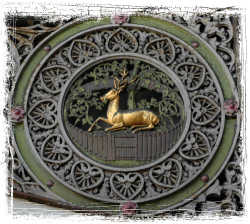 |
Although it is known as one bridge, it is actually two bridges, each bridge span carrying two pairs of railway tracks. The west bridge (near Pickfords House Museum) was for trains traveling North towards Breadsall Railway Station, with the pair of tracks nearest the outer edge for Slow Trains and the inner set of tracks (adjacent to the other bridge span) for Fast Trains. The East bridge (Ford Street side) was for trains traveling South towards Mickleover Railway Station, with the pair of tracks nearest the outer edge for Slow Trains and the inner set of tracks (adjacent to the other bridge span) for Fast Trains. So if you were standing on the corner of Friar Gate/Stafford Street corner looking towards Friar Gate Railway Bridge then trains would approach over the bridge from the right side (for example from Skegness) |
|
| Bridge Design: Friar Gate was a wealthy thoroughfare and the Council at the time felt that the bridge should be better than an ordinary plate girder bridge, thus Andrew Handyside & Co, whose manager Alexander Buchanan was also a councilor and close friend of ex-mayor Samuel Leech was instructed by the GNR to prepare three alternative bridge designs. Several members of the Council visited Manchester where a number of ornamental bridges had been put up. A highly ornamental cast iron design was chosen, This was graced with abutments of dressed stone and intricately moulded parapets and spandrels which incorporated the town’s buck-in-the-park motif. |
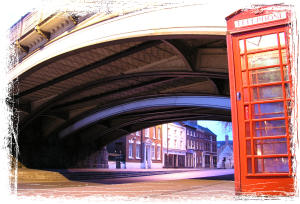 |
|
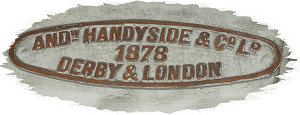 |
The creator: Andrew Handyside and Company was an iron founder in Derby in the nineteenth century His output ranged from garden ornaments to railway bridges. He produced lamp posts for the new gas street lighting (one of which still exists in the Wardwick in Derby) and was one of the first to produce the new standard Post Office letterboxes In 1871 it built the Trent Bridge at Nottingham and, in 1872, the Albert Suspension Bridge in London. Handyside died in 1887 and the firm gradually declined until it closed in 1911. The foundry was demolished and replaced by a housing estate, the only remaining Clues that remain is a street named Handyside Street (Off Duke Street, near St Marys Bridge) |
|
| Details of route North/East From Friar Gate Bridge After leaving Friar Gate bridge the route passes over Agard Street (next to where Lansport is today). Then over Brook Street and Lodge Lane and upto King Street where it passes under King Street, at this point today you can still see the iron clad bridge on King Street where the Friar Gate Line passes under the road. The line then emerges on the other side of Henry street and passes under Arthur Street, North Street and North Parade where it then travels across another of Handyside’s Railway Bridges, this time over the River Derwent. Once on the other side of the river it passes over City Road, over Old Chester Road and through Little Eaton and onto Breadsall Station. |
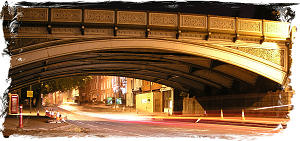 |
|
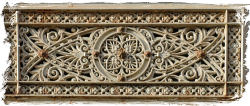 |
Friar Gate Line Closure Closure to all passenger traffic was announced on June 30, 1964. The last day of passenger operation was scheduled for September 5 1964. There was little in the way of ceremony - there were too many rail closures taking place at that time. A replacement bus service between Derby and Nottingham, via Ilkeston, was provided. Goods services at the remaining stations were progressively withdrawn in the following months, Friar Gate itself closing on September 4, 1967. Some through working of goods trains continued until May 1968. The last train through was a six-car DMU chartered by the Stephenson Locomotive Society The Flanagan and Allen song Underneath the Arches was written about this bridge. This has been confirmed by the late Colin Wardle, star of "My golden memories of Derby's silver screens" who owned Flanagan's diary. The song was written when the duo appeared at The Hippodrome, Green Lane, in 1927 and refers to the arches of this railway bridge. Credits, Acknowledgments, Books, Further Reading. |
|
More info on the Bridge :
Bird's Eye view of the bridge.
Aerial Photograph on local Live (several years old).
Aerial Photograph on Google Maps (taken late summer 2006).
This feature is being constructed at the moment and will alter over the next few weeks, be patient!
Please sign the Restore Friar Gate Railway Bridge Petition NOW !!!!
Things still to be added to this feature soon:
More info on the bridge.
Info about original Friar Gate Action Group.
This page can also be found by the easy to remember web address of www.derbyphotos.co.uk/bridge
© Andy Savage © www.derbyphotos.co.uk